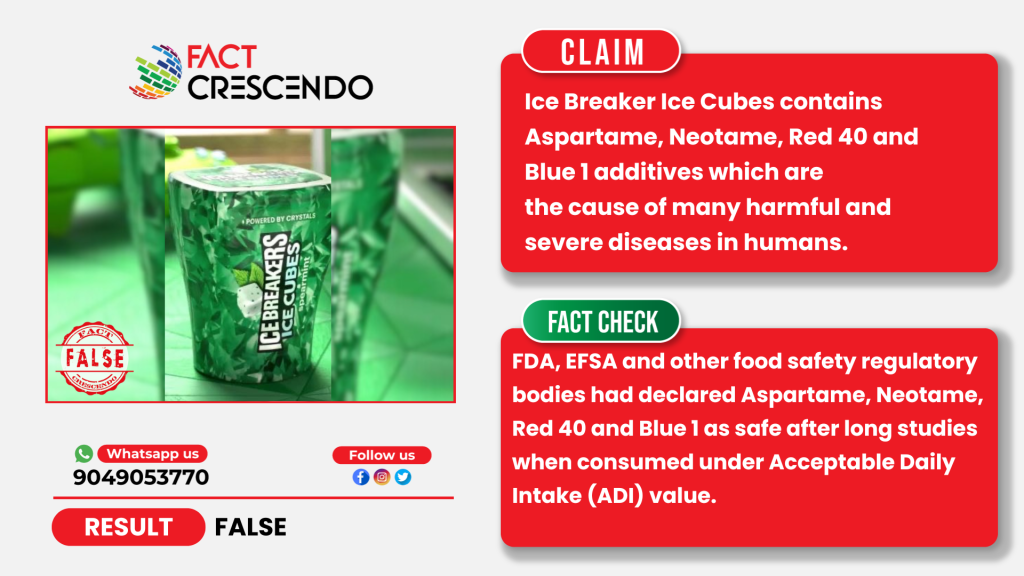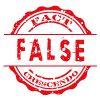
Consumers have raised concerns about Ice Breakers Ice Cubes gum, accusing the brand of using potentially harmful additives such as aspartame, neotame, Red 40, and Blue 1. Social media users claimed that these ingredients, commonly used as artificial sweeteners and colorants, have been linked to various health risks like Alzheimer’s disease, Brain fog, memory loss, ADHD etc.
However, Fact Crescendo found the claim to be false. Aspartame, Neotame, Red 40 and Blue 1 have been approved by FDA and other food regulatory bodies.
What’s the claim?
Sharing the post, social media users are claiming that Ice Breakers Ice Cubes contains harmful additives like Aspartame, Neotame, Red 40 and Blue 1 which are responsible for diseases like Brain fog, memory loss, ADHD, Alzheimer’s, kidney disease, heart failure etc.
Fact Check-
According to the information available on Hersheyland website, Ice Breakers Ice Cube contains Xylitol, Gum Base, Maltitol Syrup, Natural & Artificial Flavor, Maltodextrin, Gum Acacia, Lecithin, Artificial Color (Blue 1 Lake, Blue 1, Yellow 5 Lake, Yellow 5), Aspartame, Acesulfame Potassium, Gelatin, Modified Cornstarch, BHT, Neotame, Sorbitol and Sucralose
Is Aspartame, Neotame, Red 40 and Blue 1 approved?
Aspartame:
Aspartame is a low-calorie sweetener which tastes sweet but does not contain any natural sugars and its calorie level is much less than sugar. It is an artificial substance and made of two naturally occurring amino acids called aspartic acid and phenylalanine. These two amino acids are found in various foods and in the human body as well.
According to the World Health Organization (WHO), the International Agency for Research on Cancer (IARC) conducted a study and classified Aspartame as possibly carcinogenic to humans (Group 2B) based on limited evidence for cancer in humans. WHO had also stated that the evidence of toxicity of Aspartame was not conclusive.
JECFA also concluded that there was no convincing evidence from experimental animal or human data that aspartame has adverse effects after ingestion. JECFA confirmed that aspartame is safe to consume within the daily limit of 0–40 mg per kilogram of body weight.
We also found that the FDA approved the use of Aspartame as a sweetener in 1974. According to the report, Aspartame is considered safe for most people when used as intended, according to scientific evidence and the FDA’s guidelines. However, people with a rare genetic disorder called phenylketonuria (PKU) should avoid aspartame, as they cannot process phenylalanine, a component of aspartame.
Neotame:
Neotame is an artificial sweetener 7,000 to 13,000 times sweeter than sugar. It was approved by the FDA in 2002. It is used as a general-purpose sweetener and flavor enhancer in foods, except for meat and poultry. It is heat-stable, making it ideal for baked goods. The FDA declared neotame safe after reviewing over 110 studies on its effects on the immune, reproductive, and nervous systems.
The European Food Safety Association (EFSA) reviewed the safety of neotame and found that it is stable in food and drinks and breaks down into harmless components. Studies show that neotame is quickly absorbed, metabolized, and completely eliminated from the body, with no accumulation in tissues or harmful effects in animals or humans. Tests confirmed that neotame is not toxic, cancer-causing, or harmful to reproduction and development. Human trials found it safe even at high doses. The panel concluded that neotame is safe for its intended use in foods and beverages.
Red 40:
The European Food Safety Authority (EFSA) reviewed the safety of Allura Red AC (E 129), a food colouring allowed in the EU, and confirmed it is safe within the established acceptable daily intake (ADI) of 0-7 mg/kg body weight. While a recent study suggested it might cause DNA damage in mice at high doses, long-term studies showed no evidence of cancer, even at doses far exceeding typical human consumption. Other genetic tests and studies on its breakdown products also indicated no significant harm. EFSA concluded that the observed DNA effects are unlikely to lead to cancer, reaffirming Allura Red AC’s safety when used as a food additive.
Blue 1:
The EFSA reviewed the safety of Blue 1, also known as Brilliant Blue FCF (E 133). It was previously approved with an acceptable daily intake (ADI) of 10 mg/kg body weight per day, set in 1984. After reviewing new data on how the dye is absorbed, processed, and its effects on health, the EFSA decided to lower the ADI to 6 mg/kg body weight per day. This decision was based on updated studies showing the dye is safe at this level. The EFSA also found that most people’s intake is below this new ADI.
Conclusion:
Fact Crescendo found the claim to be false. FDA, EFSA and other food safety regulatory bodies had declared Aspartame, Neotame, Red 40 and Blue 1 as safe after long studies when consumed under Acceptable Daily Intake (ADI) value.

Title:Hershey’s Ice breaker Ice Cubes contains toxic additives? No. The additives are approved and safe to consume.
Written By: Siddharth SahuResult: False


